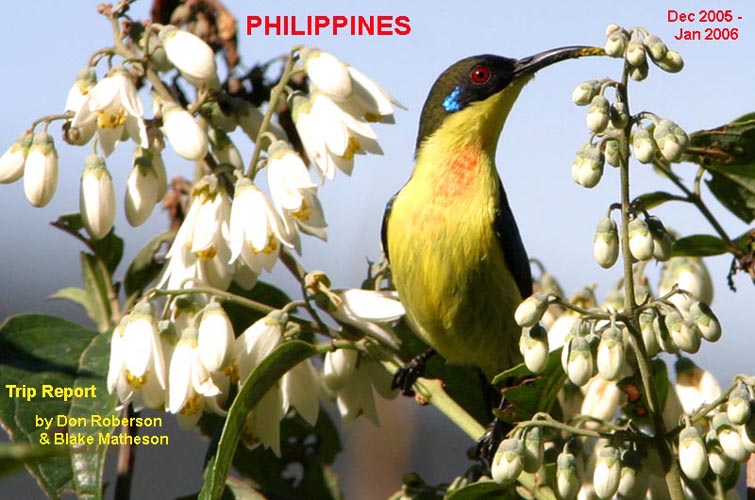

|
|
||
 16
Dec (Palawan to Negros): Up at 4:30 a.m. to leave for
the airport, but to also get as much last-minute birding in as possible.
We still needed Palawan Flycatcher, and Tim knew a spot on 'ZigZag Road,'
halfway between Narra & Puerto Princesa. We tried it — a steep gully
bounded by bamboo — early, but no response to the tape. So we wandered
around up the road, finding Crested Goshawk & Great Slaty Woodpecker,
and Blake photographed a Palawan Flowerpecker (left; © Blake
Matheson) but no flycatchers. It was time to leave but Tim suggested
we try the original spot during our final 15 minutes. We did — and the
Palawan
Flycatcher responded! Don wrote: "The call is a very soft low trill.
The bird was very secretive and circled us in the forest. I finally got
good views: small, upright, perching flycatcher with shockingly orange-brown
color on upperparts, breast and tail, and contrasting white belly. Small
pale loral-spot on otherwise blank face." 16
Dec (Palawan to Negros): Up at 4:30 a.m. to leave for
the airport, but to also get as much last-minute birding in as possible.
We still needed Palawan Flycatcher, and Tim knew a spot on 'ZigZag Road,'
halfway between Narra & Puerto Princesa. We tried it — a steep gully
bounded by bamboo — early, but no response to the tape. So we wandered
around up the road, finding Crested Goshawk & Great Slaty Woodpecker,
and Blake photographed a Palawan Flowerpecker (left; © Blake
Matheson) but no flycatchers. It was time to leave but Tim suggested
we try the original spot during our final 15 minutes. We did — and the
Palawan
Flycatcher responded! Don wrote: "The call is a very soft low trill.
The bird was very secretive and circled us in the forest. I finally got
good views: small, upright, perching flycatcher with shockingly orange-brown
color on upperparts, breast and tail, and contrasting white belly. Small
pale loral-spot on otherwise blank face."
Then it was quickly off to the airport for the 11:30 flight to Bacolod, Negros (via a stop in Cebu). When we reached Bacolod it was pouring with rain again, and that kept up the rest of the day. We used the time to check email and I shopped to replace my digital pocket camera. Found one that would work at a huge shopping mall but the computer lines to approve credit cards were down, so didn't buy it. Probably just as well — the price was higher than the U.S. |
||
17 Dec (Negros): Our only day to bird on Negros;
again we are lucky as the weather is not bad, with only light drizzles
at mid-day. A jeepney picks us up at 5 a.m. for the 1.5 hour drive to Mt.
Canloan. We get about 2/3 the way there and suddenly the jeepney breaks
down, the transmission thrown. The driver hitched a ride back to town while
we lounge on the side of the road (below left; © Anne & Jon
King). Our driver returned in just over an hour in a bright orange
jeep with a "For Sale" sign on it. We all wedge aboard and head uphill
again. We are doing fine until the hill steepens and the orange jeep breaks
down, unable to move (below right; photo © Anne & Jon King).
We leave it dead on the road and crowd into a 3rd vehicle that we stopped
— another jeepney — and we finally make it to the small village at the
base of the mountain. From here it is a long walk through small villages
and then secondary forest — from 350m (~1150' elev.) to 950m (~3115' elev.)
— to reach the remnants of primary forest. The final 200m gain was very
steep and slippery; fortunately it was a cool, overcast day. We had meant
to start our hike at 6:30 a.m. but don't get started until 8:30 and didn't
reach the forest until 10:30. Yet it all worked out fine.
|
||
We had seen the endemic Visayan Flowerpecker in the little village,
and White-vented Whistler in the secondary forest, but the real
prizes were in the primary forest: a noisy flock of White-winged Cuckoo-Shrike
(photo below left) and then a small party of curious Flame-templed Babbler
(photo below right). Both species are entirely restricted to Negros and
Panay, and neither has many published photographs. We also had local Visayan
races of White-browed Shama and Blue-headed Fantail, each candidates for
a future split. We missed Visayan Tarictic Hornbill, though; they've become
very scarce.
|
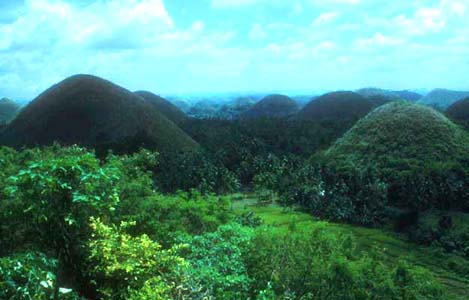 18
Dec (to Bohol): This is primarily a travel day. Catch the 8:30
a.m. to Cebu; breakfast and then taxi to the ferry docks for the 1:30 ferry
to Tagbilaran, Bohol. We tried some sea-watching on the ferry but only
some terns (most Whiskered) were seen. A van picked us up for the 1.5 hour
drive to the Chocolate Hills Guesthouse, set among the odd but aptly-named
Chocolate
Hills (right). Rajah Sikatuna National Park is nearby, and we drop
in late in the afternoon to pick up a pair of the local race of Luzon Tarictic
Hornbill. We stayed until dark and tried for owls and Philippine Frogmouth,
but did not see any. 18
Dec (to Bohol): This is primarily a travel day. Catch the 8:30
a.m. to Cebu; breakfast and then taxi to the ferry docks for the 1:30 ferry
to Tagbilaran, Bohol. We tried some sea-watching on the ferry but only
some terns (most Whiskered) were seen. A van picked us up for the 1.5 hour
drive to the Chocolate Hills Guesthouse, set among the odd but aptly-named
Chocolate
Hills (right). Rajah Sikatuna National Park is nearby, and we drop
in late in the afternoon to pick up a pair of the local race of Luzon Tarictic
Hornbill. We stayed until dark and tried for owls and Philippine Frogmouth,
but did not see any.
The Chocolate Hills Resort, where I had stayed in 1990, was expanded and much improved since then. They — like many other places we stayed on this tour — were very receptive to our needs, including the inevitable 4 a.m. breakfast, which they put together very smartly! |
|||
|
|
|||
| 19 Dec (Bohol): Up at 3:30 a.m. to get to Rajah Sikatuna
Park before dawn, to try for nightbirds again. Not much success with that.
But just at dawn an Azure-breasted (or Steere's) Pitta began
calling and Tim taped it in for fine views. It actually perched well up
(30') in a tree! Then we saw a responsive pair of Streaked Ground-Babblers.
And the group worked on seeing Yellow-breasted Tailorbird while
Don tried to chase down another calling pitta.
We spent the rest of the day on various trails through the park, up and over limestone kaarst ridges (e.g., Steere's Pitta Trail, Oriole Trail, Tarsier Trail). The forest is lovely here but, as Tim says, the birds are "very thin on the ground." Tim does spot a trio of roosting Philippine Frogmouth (photo above) which stay in the same spot all day (but are gone the next day). A fruiting tree has both White-eared Brown Dove and Amethyst Dove. But there are a plethora of other life in the forest (L to R, below): a horned frog, a flying lizard with ribcage expanded, and a praying mantis.
|
|||
| 20 Dec (Bohol): Another morning in Rajah Sikatuna Park, working the trails that have had Visayan Broadbill in the past. We even bring a couple local guides to help us but can't turn up this much-wanted but rarely seen species. We have Amethyst Dove again (possibly the same one), and Rufous-tailed Jungle-Flycatcher. Then its back to Tagbilaran for the mid-afternoon ferry to Cebu, but it is late. It won't leave until 4 p.m., and we get to Cebu City after dark. | |||
21 Dec (Cebu): When you fly over Cebu, or, indeed, many other Philippine islands, you see nothing but a deforested landscape (above). Cebu is almost entirely deforested. When I was there in 1990, it was thought that no patches of virgin forest remained. Nearly half of the resident birds of Cebu were considered extinct (Brooks et al. 1995). In the past decade, however, researchers have found tiny patches of forest remaining, such as this one (right; photo © Anne & Jon King) at the little village of Tabunan. The only reason this forest is here is because underneath of the trees is a steep cliff of kaarst — tough, folded limestone with razor-sharp edges. The rocks can't be cleared for fields (although they were burning trees at the edges the day we were there, in violation of local law). In 1993, the Cebu Flowerpecker — long considered extinct — was rediscovered here (Duton et al. 1993), and since then the local Cebu races of Streak-breasted Bulbul and Orange-breasted Flowerpecker have been rediscovered. Of course the flowerpecker remains critically endangered, with a population estimated below 50 (Birdlife International 2000), and most birders here miss it (J. Hornbuckle, pers. com.). It is almost a 2 hour ride in a jeepney from Cebu City to Tabunan, which lies at the end of a long, steep, and muddy road that must make it inaccessible to vehicles in the wet season. Our arrival surprises the local guide, Oking, who had not been told we were coming. But he and his family were very hospitable, and we tromped off through a series of muddy ag fields to reach the forest edge. It started to rain (of course) but we first managed to tape in the endemic Black Shama, once considered to be the prime Cebu endemic. One then climbs a steep goat-path and then a series of metal ladders to reach a metal platform anchored to the rocks and high in the canopy. The view of the forest here is quite good, and it seats six people comfortably. We bird here from 8 am to noon. There is another viewpoint, higher in the rocks, with even a better view of the forest (photo below; Anne at a perch at the upper viewing spot © Jon King). It can only hold about 3 people, so only Jon & Anne & Oking go to that perch (which takes even more strenuous rock-climbing). We all remain until about 2:30 pm, or a total of over 6 hours birding at the site in total. Fortunately, the rain lets off and the day became very pleasant. |
|||
|
|
|||
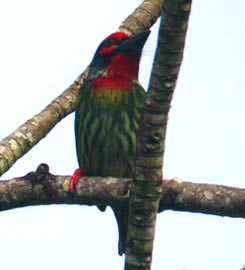 From
the viewpoints we searched the canopy for birds. Among those we observed
was Philippine Pygmy Woodpecker (far left) and the distinctive,
red-headed cebuensis race of Coppersmith Barbet (near left;
© Blake Matheson). Early in the morning, some (e.g., JK, BTM) got
views of the endangered
Streak-breasted Bulbul (and JK would have
additional views in the afternoon from the upper viewpoint). From
the viewpoints we searched the canopy for birds. Among those we observed
was Philippine Pygmy Woodpecker (far left) and the distinctive,
red-headed cebuensis race of Coppersmith Barbet (near left;
© Blake Matheson). Early in the morning, some (e.g., JK, BTM) got
views of the endangered
Streak-breasted Bulbul (and JK would have
additional views in the afternoon from the upper viewpoint).
Red-keeled Flowerpecker was common; we often had them either in sight or heard their distinctive calls. Oking had explained to us some of the calls of Cebu Flowerpecker, especially the soft but sharp double-noted flight call. Those of us on the lower platform heard it twice, and the calling bird was also heard other times from the upper platform. At about 11 am a small, brown, female flowerpecker landed briefly in the canopy nearby. Unfortunately the front half was behind leaves for most but at least one of us (DR) got good views of the head and bill to identify it as a female Cebu Flowerpecker (more details in the annotated trip list). Later, at 1 pm, and just after we'd heard the flight call, another one of us (BTM) saw a male perched briefly in the canopy. We left by 3 pm to catch the overnight ferry to Cagayan de Oro, Mindanao.
This was an interesting experience. Most passengers sleep in dormitory
style bunk beds in one huge room. We were booked into 4 of the 6 'suites'
aboard the ferry — quite nice full-size rooms with individual bathrooms.
It was a fine sleep while out to sea.
|
|||
| 22 Dec (Mindanao: to Mt. Kitanglad): Our overnight
ferry from Cebu docked at Cagayan de Oro at 6 a.m. We had breakfast and
then drove two hours inland to the little town of Dalwangan. Here, one
is supposed to pay one's respect to the village elders as there has been
conflict between the porters, cooks, and guides that are essential for
any visit to Mt. Kitanglad, and those in the town who don't directly benefit.
We were told there would be a ceremonial sacrifice of a chicken. As luck
would have it, the key elder had not been informed of our pending visit
by government park officials (Mt. Kitanglad is a national park 'on paper')
and was upset. The 'ceremony' did not occur, but Tim paid enough money
for the chicken anyway . .
We then continued farther up the road until it is blocked by a river. Here, in a small village, we gathered our porters and horses and packed all our gear for the hike to Tim's Mt. Kitanglad camp [for reasons I never learned, everyone is now spelling this "Kitanglad" instead of "Katanglad" as had been used in 1990]. It is an hour-and-a-half hike from our final village (at 1151m = 3775' elev.), up a very muddy track through grasslands, to reach our accommodations (at 1368m = 4488'; JK had a GPS device that permitted elevation to be determined accurately within a few meters).. When I was here before (1990) we stayed in tents. Since then, however, Del Monte Corp. built an open-air "lodge" that was given to the park service and is now abandoned except for Tim's birding trips. He maintains the two-story cement and wood building. Downstairs in "Fisher's Lodge" (photo below left) is a huge open-sided dining, kitchen, and clothes drying area. There are even flush toilets! And a private shower stall. A local family stays with us to cook, heat water for bathing, wash clothes, and the men act as guides. Everyone slept upstairs on pads and sleeping bags, except for Don who was given a separate tent outside. There are kerosene lamps at night for dinner and writing the day's notes (below left), and these attract some of the most spectacular moths I've ever seen (below right; both photos © Anne & Jon King). |
|||
|
|||
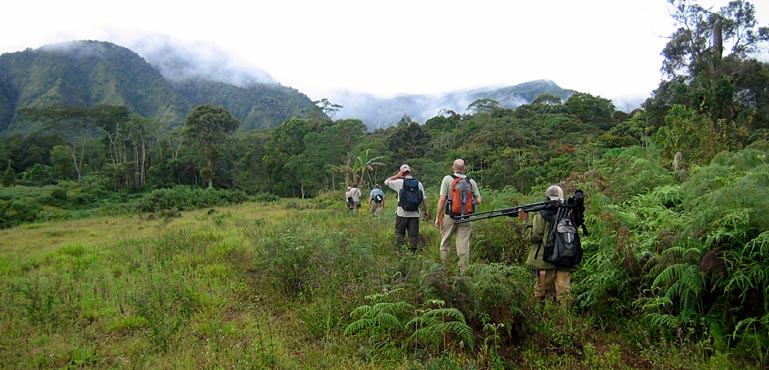
|
|||
| Fortunately, there are still a wide variety of birds on the mountain. We saw Colasisi ("Philippine Hanging-Parrot;" above left; © Blake Matheson) daily, and Mountain White-eye (above right) was very common. Other montane specialties recorded included Mindanao Racquet-tail, McGregor's Cuckoo-Shrike, Stripe-breasted Rhabdornis, Black-and-cinnamon Fantail, Gray-hooded Sunbird, Red-headed Tailorbird, White-browed Shortwing (seen briefly), Olive-capped Flowerpecker, Black-masked White-eye, and Cinnamon Ibon (traditionally placed with white-eyes but not even closely related to them). There were large flocks of migrant Eye-browed Thrushes flying early and late. At the highest elevations we reached (above 1900m, or ~6200') we had flocks of Apo Myna, a half-dozen Apo Sunbird, and JK & BTM had White-cheeked Bullfinch. Our highest point was 1961m (6434' elev.). | |||
The other peak moment for me on Kitanglad this time was seeing the newly-described Bukidnon Woodcock. This species was not even known to science in 1990. Today, it has a territory right next to Fisher's Lodge. Every morning just before dawn (~5:10 a.m.) and every dusk just as it got too dark to see (~5:40 p.m.) we would hear the male roding in the field just above the camp, and flying right behind the lodge itself, but too low and against the forested background to pick it up. To see it, one got to the field a few hundred yards above the lodge in time, and waited for the woodcock to fly directly overhead. We all did this once or twice, and all had views. The call is soooo eerie: like a apparition jangling ethereal keys as it zooms down a a ghostly passage. We were plagued by rain on Kitanglad. One afternoon was entirely washed out by heavy rain, and it rained every night. This wiped out plans for owling. Fortunately, the woodcock displayed even in a downpour. But its displays were very brief — just 2 or 3 short flights each daw and dusk — and that was it. |
|||
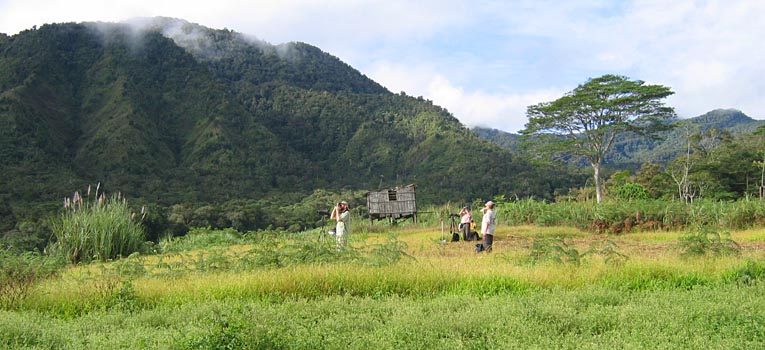 |
|||
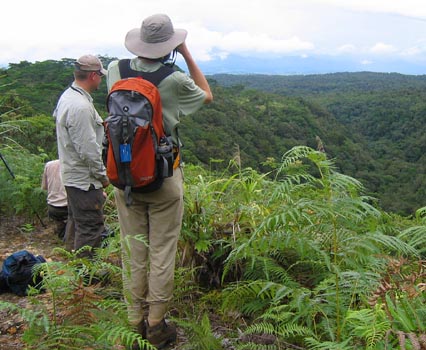 Of
course, for most the major attraction of Mt. Kitanglad is the chance to
see the Great Philippine Eagle, a species that I long ago chose
as "the best
bird in the world." This pair nests every two years. They did not nest
last year so it is thought they might be on a nest somewhere this year.
However, unlike some years in the past, not even the locals knew where
the nest was this year. So one hopes to see it while hiking or from a viewpoint
overlooking the canyon. There are many spots to get views of the canyon
and the forest beyond, but the major sites we called the "middle viewpoint"
(above, about 1.5 hour walk above camp) and the "upper viewpoint"
(left; about 2 hour walk above camp; both photos © Anne King).
Between the two sites we spent over 10 hours watching for the eagle. Of
course, for most the major attraction of Mt. Kitanglad is the chance to
see the Great Philippine Eagle, a species that I long ago chose
as "the best
bird in the world." This pair nests every two years. They did not nest
last year so it is thought they might be on a nest somewhere this year.
However, unlike some years in the past, not even the locals knew where
the nest was this year. So one hopes to see it while hiking or from a viewpoint
overlooking the canyon. There are many spots to get views of the canyon
and the forest beyond, but the major sites we called the "middle viewpoint"
(above, about 1.5 hour walk above camp) and the "upper viewpoint"
(left; about 2 hour walk above camp; both photos © Anne King).
Between the two sites we spent over 10 hours watching for the eagle.
On our first full day, we had already put in several hours and decided, since the weather was good, to continue to the upper elevation forest in search of the two "Apo birds." We gathered up our backpacks and began the hike; Blake and Volker had lingered behind just a moment longer, but they were also heading up the trail. It was then that Carlito shouted "Eagle!" We all heard the shout and began back down the slippery trail as fast as each of us could manage. Blake and Volker got there first, and had the Philippine Eagle pass right by them as it flew down the canyon (see Blake's account, below). The rest of us arrived just moments too late. Blake and Volker were on such a high just then — one had to smile at their exuberance, even though personally missing the experience. The second day we spent six hours at the middle viewpoint. About mid-day, Jon saw the huge eagle swoop up from the canyon below to a snag, and just as quickly glide off the snag and over into a secondary valley. Tim saw this out of the corner of his eye. Neither got their bins on the bird, and the rest of us never saw even a feather, although we are all standing around the viewpoint. Most of us had our view blocked by a tree — and by the time we rushed to where Jon was, the eagle was gone. So that's how it happened that only 3 of the 5 of us on the trip saw the eagle this time. One can do wonders with PhotoShop. I took a photo of the forest background from the viewpoint, and now I've added in a shot of the eagle that I took back in 1990. I've tried to "re-create" what Blake and Volker might have seen. This PhotoShop composite — the 1990 eagle and the 2005 forest — is below. |
|||

|
|||
| 25 Dec (Mindanao: Kitanglad to Bislig): Christmas was a travel day, and just as well as it poured with rain dawn to dusk. Our hike down to Dalwangan was wet and eventful, especially the treacherous river crossing at the bottom. The river was now a roaring torrent. It took many arms to pull us all across. Then it was a 10-hour drive by van to Bislig, via Davao, and the last 3-4 hours over wet dirt roads. We were very happy to finally reach the Paper Country Inn, just outside Bislig, on the eastern coast of Mindanao. This very pleasant hotel would be our host for the next 4 nights. | |||
|
|||
|
|||
|
|||
| PHOTOS: All photos on this page are © 2006 Don Roberson,
except those © Blake Matheson, © Anne & Jon King, or ©
Volker Schmidt, and so indicated; all rights reserved. Many other shots
from this trip are scattered about this web site.
Literature cited: Birdlife International. 2000. Threatened Birds of the World. Lynx Edicions, Barcelona, Spain.TOP TO LIST OF BIRD FAMILIES OF THE WORLD |